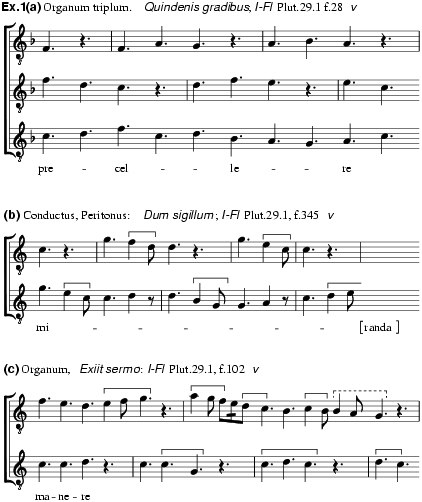
(Lat. hoquetus, (h)oketus, (h)ochetus; from Fr. hoquet, Old Fr. hoquet, hoket, ocquet, etc., related to English hickock, hicket, hiccup, and similar onomatopoeic word formations in Celtic, Breton, Dutch etc., meaning bump, knock, shock, hitch, hiccup; attempts at etymological derivation from the Arabic must be regarded as unsuccessful).
The medieval term for a contrapuntal technique of manipulating silence as a precise mensural value in the 13th and 14th centuries. It occurs in a single voice or, most commonly, in two or more voices, which display the dovetailing of sounds and silences by means of the staggered arrangement of rests; a ‘mutual stop-and-go device’ (F.Ll. Harrison). Medieval authors (see below) mentioned the existence of this practice in popular music.
One of the many significant stylistic changes brought about by Perotinus in the emergent art of measured polyphony was his cultivation of rhythms more spacious and measured than those which prevailed in the relatively fast, running dupla of the discant sections presumed to be by Leoninus, in which the tenors were laid out in irregular groups of simple longs. Corollaries of this change were the appearance of double longs, which could now be assigned to the tenor notes of discant passages; the greater foursquareness of phrases; the recognition of silence as an intrinsic measurable component of polyphony, potentially equivalent to sound as an element of counterpoint; the consequent change in meaning of the little stroke known as tactus (also referred to as divisio) from a symbol simply denoting the end of a phrase (i.e. a brief, mensurally insignificant suspirium) to a measurable rest (pausa); the emergence of the first tenor patterns (consisting of four-beat phrases); and the awareness that the voice parts of a polyphonic complex, whose phrases were now delimited by precise rests, did not need to coincide in their phrase articulation, but could be made to overlap (see ex.1). Further refinements of this technique were the curtailment of some of the phrases in one or more parts by means of rests (ex.2a) and the free addition or insertion of rests (ex.2b–d). The irregularity of such phrases or phrase elements, often no more than single notes set off by rests, exemplifies what medieval writers called imperfect modes.

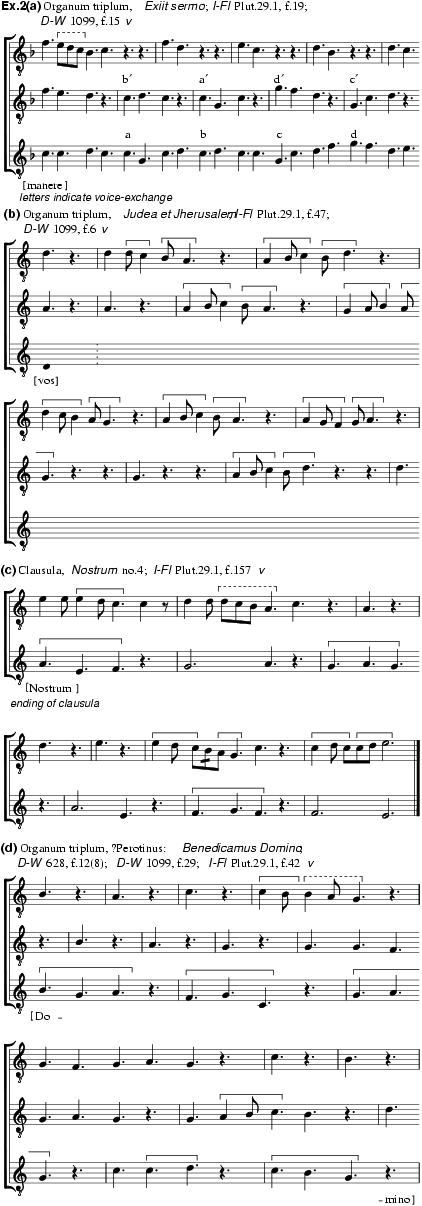
The earliest known definitions of the hocket are given – about three-quarters of a century after the appearance of the technique – by three contemporary writers: Franco of Cologne, Lambertus and the so-called St Emmeram Anonymous (1279). The last named presents us with the fullest and most illuminating description:
Hocketing is produced either by cutting off sound or without such truncation. In the latter case such passages may or may not have text. If they do, they will conform to one of the modes, such as the 1st, 2nd or 3rd, or will observe the compatibility of one mode with another, or with several, and the alternation of groups of notes with rests will proceed subtly from here and there; sometimes one may encounter cases of truncation, but they are rare. When there is no text, the alternation of the voices is the same, but more frequent and also with more truncations. Hockets involving truncations may be composed over a tenor laid out according to one or several of the modes, or without any tenor, i.e. fundament. If such truncations are founded on a tenor, this will be without text, except in some suitable cases in motets, for example in Povre secors [D-BAs 36, F-MO 31, Pn 13251, 54] and others like it. … In hockets not based on a modal tenor we encounter irregular and unpatterned conformations of longs, breves and also semibreves, either each kind grouped separately or all mixed together; thus they are seldom, if ever, reducible to any kind of equivalence fitting one of the modal species.
This last type, he pointed out somewhat later, occurs ‘in aliquibus conductis sine tenore proprio hoquetatis’ (‘in some conducti [i.e. the caudas of conducti of which he gave an example] with hockets without the appropriate tenor’ [i.e. without a patterned cantus firmus, which are foreign to the nature of conducti], though he added still later that some modern hockets based on a Gregorian tenor were also irregular. In the course of his description of cantus truncatus (polyphony with truncations) he distinguished between perfect and imperfect hoquetatio; in the latter, only one of the voice parts exhibits truncations and there is therefore no interlacing of voices. He also differentiated between compositions in which hocketing is continuous and those in which it occurs occasionally; in other words, the term hoquetus designates both a technique of composition and a piece completely written in this manner (Sowa, 97ff; Yudkin, 224–6).
The emphasis placed by the above writer on a proper mensural foundation indicates that the principal use of hoquetus was in cantus firmus polyphony, where, except for the increasingly old-fashioned organal style, the tenor made the precise measurement of all elements mandatory. Occasional hocket passages also occur in caudas of conducti. The proposition that hocketing preceded the rise of musica mensurata (see Dalglish) is based on earlier medieval reports of extravagant performances of monophony, which, in view of the hocket's essential need of strict coordination, have no apparent relevance.
Obviously, this writer's ‘hocket without truncations’ refers to the technique illustrated by ex.1 (which is closely related to the device known as Voice-exchange). Such overlapping of phrases can indeed be found in musica cum littera (motets, especially ‘peripheral’ motets and the so-called isoperiodic motets composed in England in the 13th and 14th centuries) as well as in its historical predecessor, musica sine littera (in the discant passages of organum duplum, triplum and quadruplum, and in clausulas). The writer's statement that hockets with truncations (per resecationem) generally have no text, ‘except in some suitable cases in motets’, is particularly revealing. In such cases, which are indeed quite rare in 13th-century motets, they sometimes tend to function as suitable rhetorical ornaments (e.g. exclamations). But primarily they occur in passages in discant style without text, or as independent untexted hocket compositions. The latter therefore constitute the earliest known instrumental (non-verbal) polyphony: music that, by definition and unlike many clausulas, was not intended to be equipped with poetry. Such pieces, which can, of course, also be performed vocally, are preserved in D-BAs (nos.102–8, one of which the word viellatoris identifies specifically as instrumental, at least in origin), in F-Pn lat.11411, no.3, and in F-MO 5 (3 is a version of D-BAs 106, while F-MO 2, 64, 128 and E-Mn 71 are versions or concordances of D-BAs 104). A 14th-century specimen is Machaut’s Hoquetus David, in which the part above the tenor is designated hoquetus. That many more such compositions, now lost, must have been written can be inferred from the reference in the treatise by Jacobus of Liège to ‘hoketos … duplices, contraduplices, triplices et quadruplices’ (Coussemakers, i, 429a). Only one four-part (vocal) hocket is known; it is the final section of a Gloria trope composed in England in the late 13th century (see Burgate, R. de).
The use of hocket as an exclamatory or pictorially descriptive device disappears from the motet in the late 13th century, and in the 14th century is found occasionally in chansons, in Italian ballatas and in chaces and cacce. Melismatic endings (or sectional endings) of secular compositions at times also exhibit hocket technique in a manner first manifested in some 13th-century conductus caudas. A motet like F-MO 294, on the other hand, shows that the earliest device to emphasize the new strophic structure of 14th-century motets was the isorhythmic recurrence not only of phrase endings, but of hocket passages. From the 1320s onwards hockets occur in many 14th-century motets. Thus an Italian writer of a mid-century Latin treatise mentioned ‘uchetti’ particularly as a feature of motets. Their function now was to serve as structural ornaments, placing in relief the tectonic design generated by the tenor.
In general, medieval writers confined their definitions of hocket to the technique of truncation, which according to Franco (CSM, xviii, 77) is synonymous with hocket. Odington described it as a species of polyphony with or without text, known as truncated music, ‘in which … one is silent while another sings’ (CSM, xiv, 140 and 144). The comments of most later writers (e.g. Pseudo-Tunstede, Coussemakers, iv, 296) are derivative and largely recapitulate Franco and Odington, whose definition has also been adopted by modern musicology. Only Johannes de Grocheo reported an apparent popularization of hocketing, which as a polyphonic device properly belonged to the exalted sphere of ars musica:
Anyone who wants to make a two-part hocket arrangement, i.e. for a first and second singer, must divide the song or tune which is to be so arranged and apportion it accordingly to each. Such strains can end with bits of appropriate addition, as long as their mensuration is not interfered with. For in this way one overlaps the other in the manner of roof tiles, and thus they will cut each other off continually.
This is a relatively simple procedure that presumably required no notation for its convivial performance. A rather sophisticated example, in which each portion is ultimately reduced to the tiniest dimensions, is furnished by the two lowest voices of a fragmentarily preserved four-part English motet of the early 14th century (ex.3). This example also demonstrates the quasi-variational function hocketing occasionally fulfilled. Instances of such treatment can already be found in caudas of conducti of the early 13th century, in which hocket technique is at times applied to the melodic substance of preceding sections (ex.4). The ‘peripheral’ motets of about 1300 tended to assume some of the functions and certain stylistic features of the moribund conductus, and similar, though far more elaborate variation hockets occur in some of them (e.g. F-MO 311 and the English motet preserved in MO 323–4).
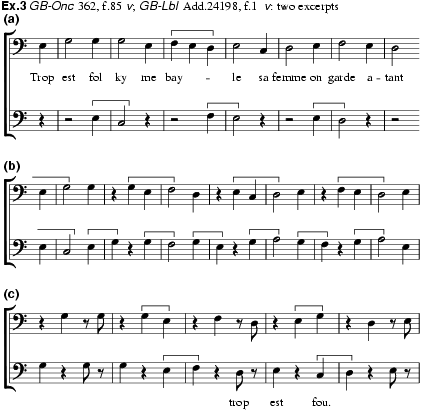
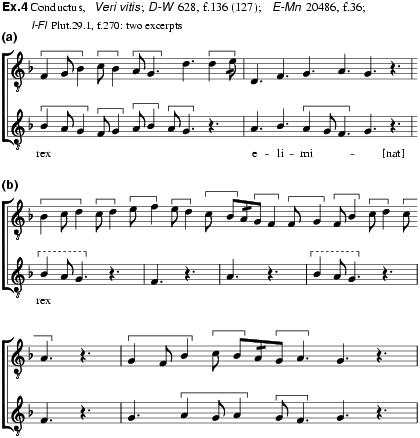
The effect of hocketing is known from areas other than western Europe and from times other than the Middle Ages. Thus hocket-like techniques have been described in African music, and silences are certainly prominent in some contemporary composers' works, such as those of Webern, Feldman, Babbitt and Cage. Yet, the conceptual matrix from which these phenomena arise is quite different from the medieval idea of silence as a contrapuntal value. In modern composers' works hocket-like effects are the result of concern with texture or colour, while non-Western ‘hocketing’ generally results either from the necessity of allocating portions of a melody or of a complex sound pattern (as in the gamelan music of Bali) to more than one instrument because of limitations of range, or from the social partiality for rapid and colourful antiphonal interchange.
That particular result of hocketing of course also delighted the medieval West: witness the use of such terms as ‘merry hockets’ (‘hoketi lascivi’, Lefferts, 104) and the procedure described by Johannes de Grocheo. The latter, who often reported on the music of his time in terms of its human environment, mentioned that youths and temperamental people were particularly fond of hoquetus ‘propter sui mobilitatem et velocitatem’. It is this ‘jazzy’ quality that usually caused hockets to be composed in the smallest available note values (cf Lefferts, 104, 174–6). Since by the later 13th century semibreves and breves had become equivalent in duration to the breves and longs of earlier times, the 5th-mode tenors of some hockets of the mid-13th century were evidently later rewritten in the 2nd mode, with the result that in many cases hocket passages in the upper voices, originally involving breves and longs, now used semibreves and breves (cf D-BAs 104 and 106; Reckow, i, 61; Sowa, 100–04; Yudkin, 230–36). The ‘jazzy’ quality of hockets occasionally prompted ecclesiastical disapproval, such as that in the bull of Pope John XXII (1324–5), in which he accused the musicians of his time of endless abuses, one of which was that ‘melodias hoquetis intersecant’ (‘they cut the melodies apart with hockets’). Nonetheless, the hocket did not die out until about 1400, when the rise of new compositional concepts caused it to become old-fashioned and inappropriate. It is interesting that some of the latest compositions to exhibit hocket technique are strictly liturgical: mass movements, especially certain isorhythmic compositions in the Old Hall Manuscript. Ultimately, in works written in the early years of the 15th century by composers both in Italy and under Italian influence (e.g. Ciconia, Cesaris, Grenon; Du Fay's Gloria ad modum tube) the practice transformed itself into imitative antiphony (ex.5).
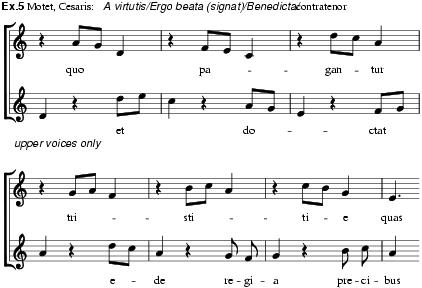
S. Debenedetti: ‘Un trattatello del secolo XIV sopra la poesia musicale’, Studi medievali, ii (1906–7), 59–82, esp. 79
H. Sowa, ed.: Ein anonymer glossierter Mensuraltraktat 1279 (Kassel, 1930), pp.xxv–xxvii, 97–103
E. Rohloff: Der Musiktraktat des Johannes de Grocheo (Leipzig, 1943), 57–8
H. Husmann: ‘Das System der modalen Rhythmik’, AMw, xi (1954), 1–38, esp. 26–7
R. Brandel: The Music of Central Africa (The Hague, 1961/R), 31–2
J.H.K. Nketia: ‘The Hocket Technique in African Music’, JIFMC, xiv (1962), 44–52
F. Reckow: Der Musiktraktat des Anonymus 4 (Wiesbaden, 1967)
W.E. Dalglish: ‘The Hocket in Medieval Polyphony,’ MQ, lv (1969), 344–63
F.F. Hammond, ed.: Walteri Odington Summa de speculatione musica, CSM, xiv (1970), 140, 144 [the musical examples require correction, and text items 6–14 must be read in the following order: 8, 9, 12–14, 6, 7, 10, 11]
E.H. Sanders: ‘Medieval Hocket in Practice and Theory’, MQ, lx (1974), 246–56
W. Dalglish: ‘The Origin of the Hocket’, JAMS, xxxi (1978), 3–20
P. Jeffery: ‘A Four-Part In seculum Hocket and a Mensural Sequence in an Unknown Fragment’, JAMS, xxxvii (1984), 1–19
W. Frobenius: ‘Hoquetus’ (1988), HMT
J. Yudkin: De musica mensurata: the Anonymous of St. Emmeram (Bloomington, IN, 1990)
P.M. Lefferts, ed.: Robertus de Handlo: Regule (Lincoln, NE, 1991)
ERNEST H. SANDERS